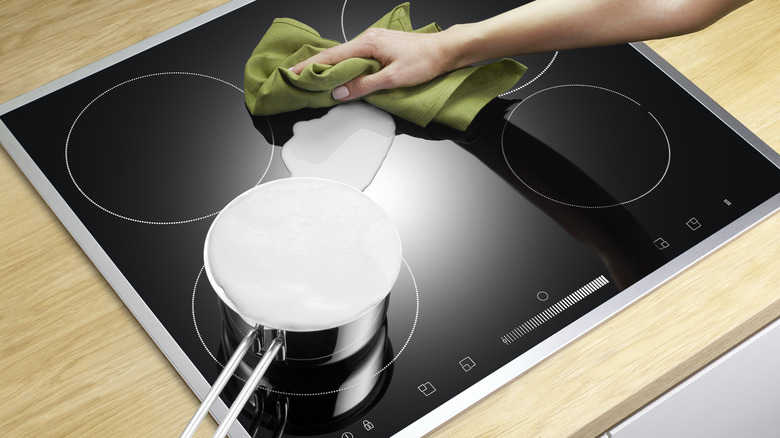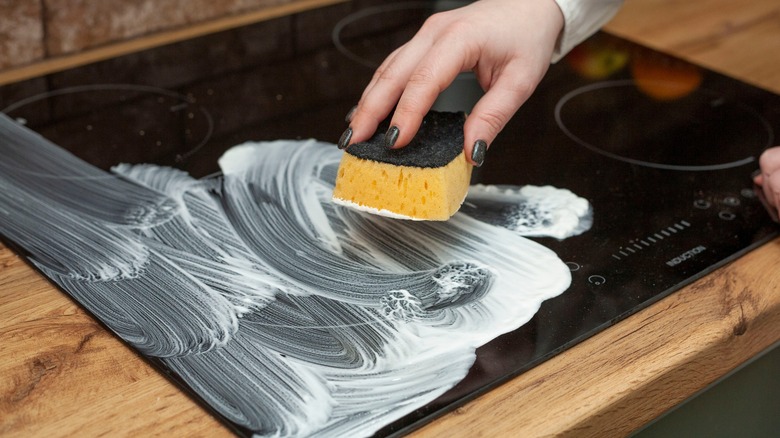How To Clean An Electric Stovetop And Eliminate The Gunk
We may receive a commission on purchases made from links.
Both gas and electric stoves require regular maintenance, but the latter are easier and faster to clean. Most types of electric stoves have glass or ceramic surfaces that can be wiped with a microfiber cloth. These appliances also tend to accumulate less grime than gas cooktops, which can significantly reduce cleaning time. Plus, it's okay to use kitchen staples, such as vinegar or lemon juice, to remove the gunk and keep your stove in tip-top condition.
Electric stoves are easier to use and maintain than gas stoves, making them ideal for those with a busy schedule. They also provide even and consistent heat distribution, which comes in handy when simmering delicate sauces or melting chocolate. Some chefs prefer gas cooktops, but their electric counterparts are often safer and more efficient. For example, a 2022 study found that gas stove pollution may be responsible for nearly 13% of childhood asthma cases in the U.S., according to the International Journal of Environmental Research and Public Health.
The proper way to clean an electric stovetop
Some electric stoves are easier to clean than others, depending on their design. If your stovetop has drip pans and raised burners, you'll need to remove and clean them separately. Generally, it's best to remove the grease with dish soap and water or natural ingredients, such as baking soda or vinegar. (Some people use specialized products, such as the Weiman Cooktop and Stovetop Cleaner, but that's a matter of personal preference.)
First, use a damp cloth to wipe away any loose crumbs and food particles from the stovetop. Remove the coils and drip pans, scrub them with a soft toothbrush, and then wipe them with a damp cloth or dish sponge soaked in white vinegar. Another option is to crank the heat to high (before removing the coils) for up to three minutes to burn off food debris. Let the stove cool, take the burners out, and wipe off any remaining residue as described above.
Last, mix a half cup of baking soda with water to make a thick paste. Apply it to the stovetop and burners, leave it for 20 minutes, and then remove it with a damp cloth. Alternatively, use a mixture of baking soda and white vinegar or lemon juice to get rid of dried grease and tough stains. A plastic scraper will do the trick, too, but use it with caution to avoid scratching your stovetop. When you're done cleaning, wipe the surface with a clean, dry cloth.
How to keep your stovetop clean between uses
White vinegar, lemon juice, and baking soda can make it easier to keep your stovetop clean between uses. For example, you can spray a mixture of lemon juice and water onto it after cooking to remove grease and stains. Wipe the area with an old T-shirt, towel, or microfiber cloth. This will reduce the need for deep cleaning and prevent debris buildup.
Cleaning a hot stovetop is never a good idea, so you should let it cool before removing the debris. Also, steer clear of window cleaners, detergents, and ammonia-based products; they can damage the stove finish. If you notice any foul odors, make a paste with baking soda, water, and essential oils (10-15 drops should be enough). Spread the mixture over the stovetop, leave it on for at least 10 minutes, and then wipe it with a dry towel or cloth.
Apart from that, you can clean your stovetop with toothpaste to remove burnt food and stubborn stains. This cleaning solution is suitable even for delicate surfaces, including glass stovetops. Also, note that some stoves have removable burners, so you can place aluminum liners beneath them. These protective covers will collect grease, food particles, and spills, making cleaning a breeze.


